Current State of Digital Experience Platform AI: How Optimizely is Making Intelligence Actionable
28 mai 2025 • 10 Minute Read • Elizabeth Spranzani, Chef de la direction technologique
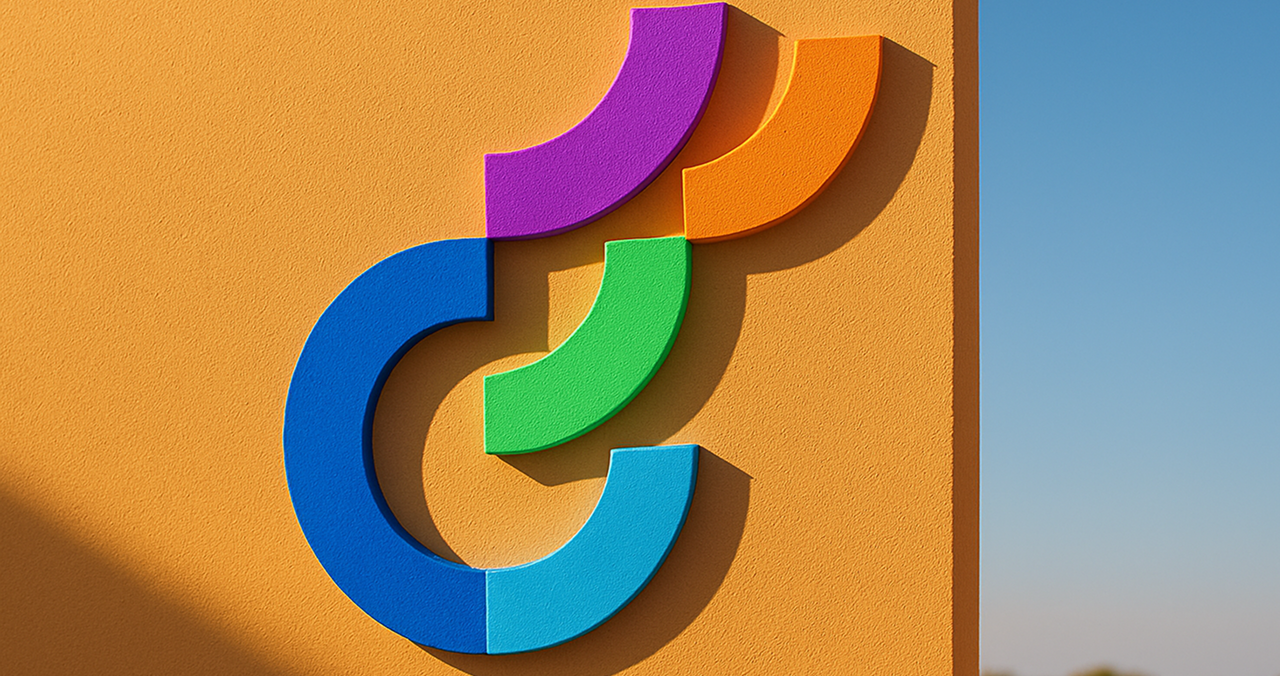
What if your digital experience platform could make smarter decisions, faster than your team ever could?
As SaaS platforms evolve, AI is becoming the engine behind this type innovation. Optimizely has long been positioned as a leader in experimentation and optimization, and is now embedding AI into the core of its digital experience platform (DXP) to help marketers and developers move faster, test bolder ideas, and unlock more value from every digital interaction.
And this isn't just roadmap talk. AI is already here, and it's showing up in real features and powering real workflows.
But with so much buzz around generative AI and the promise of autonomous agents, the key question becomes: What can AI actually do for you right now in Optimizely?
To make sense of that, it's helpful to look at the current phases of AI development as it plays out across digital platforms:
- Generative AI creates content, code, or campaign structures using large language models (LLMs).
- Contextual AI provides suggestions and decisions that are aware of your brand, business rules, and content.
- Agentic AI automates multi-step actions based on defined goals and inputs in early-stage systems.
If you're wondering, agentic systems typically include the ability to configure the following:
- A defined purpose or use case
- Instructions or guidelines for behavior
- Access to source data or content for context
- Defined actions the agent can take
In Optimizely’s case, these capabilities are becoming increasingly visible across the platform, from content generation and personalization to testing, analysis, and even campaign orchestration.
In this article, we'll uncover what AI look like in Optimizely's digital experience platform (DXP) today, where it stands apart from competitors, and what’s on the horizon.
Optimizely + AI: Opal Ushers In a Smarter Era of Experimentation and Campaign Orchestration
Optimizely is leading the AI race in helping marketers move faster, work smarter, and make better decisions. With Opal, Optimizely's new AI system powered by Google Gemini, Optimizely adds smart features across its tools for content, experimentation, commerce, and data.
What is Optimizely Opal?
More than just an interface to an LLM, Opal is an agent orchestration platform for marketing in which you can create AI agents for marketing use cases and orchestrate them across workflows. It’s an extensible system for structured guidance, embedded ideation, content generation, and campaign execution.
While many platforms are still experimenting with AI as an add-on, Optimizely is already integrating it at the core of product workflows. There's a lot of new functionality, but it also incorporates features that have existed in some of these products for years.
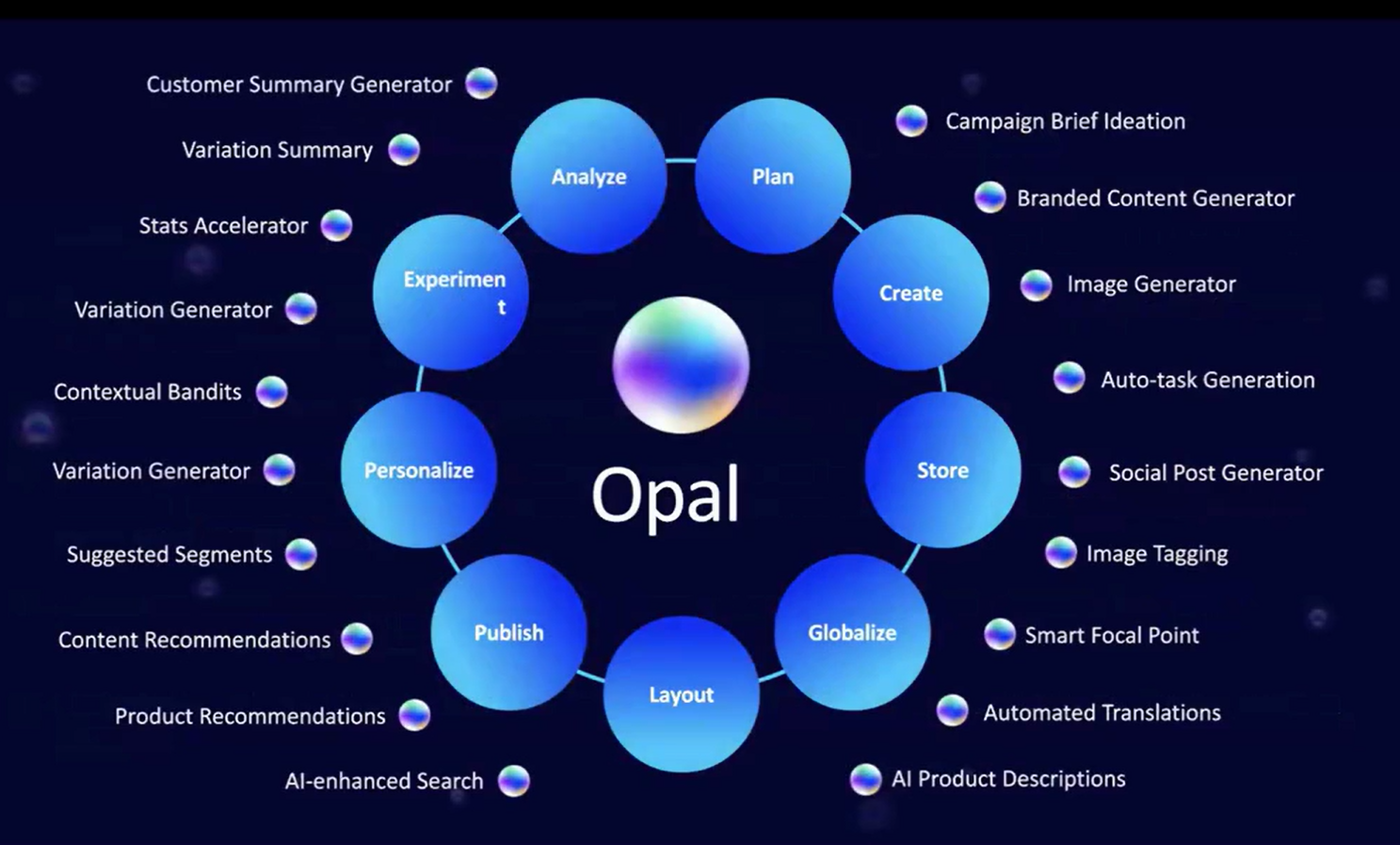
So what does that mean for teams using the platform today, and how much of the promise is already available?
Optimizely focuses on providing a great foundation to build upon, and, although it's still early days, especially for agentic capabilities, the platform has put in a lot of effort to make sure Opal is available across all of their flagship products. The Generative AI capabilities are good and most mature inside the Content Marketing Platform (CMP), but are also available in the Content Management System (CMS), Optimizely Data Platform (ODP), and Experimentation Platform (EXP). The capabilities are leveraged within each one via either a chat interface or explicit features.
Unlike some of its competitors, Optimizely is not making a subset of the new Opal features available for free. It's either on (and paid for), or it isn't. However, Optimizely is giving all customers a large number of credits right away, so they can use Opal freely for the next few months.
Additionally, AI features that have always been part of Optimizely, like image tagging, semantic search, and content or product recommendations, will still be available to current customers. Existing CMP customers who don't have Opal will still have access to the non-Opal AI chat.
Customers can train Opal on their brand, but the setup is still simple and manual. It’s done through “Instructions,” which are Opal’s early-stage, basic agents. Each Instruction has just three text fields: name, instructions, and when/where to use it.
Right now, you can’t upload files, set knowledge sources, define actions, or add conversation starters—everything has to go in as plain text. Beyond brand context, the instructions can support anything that needs context or simple agent-like behavior. So, Opal administrators can start building simple agents today, usable anywhere Opal chat is available.
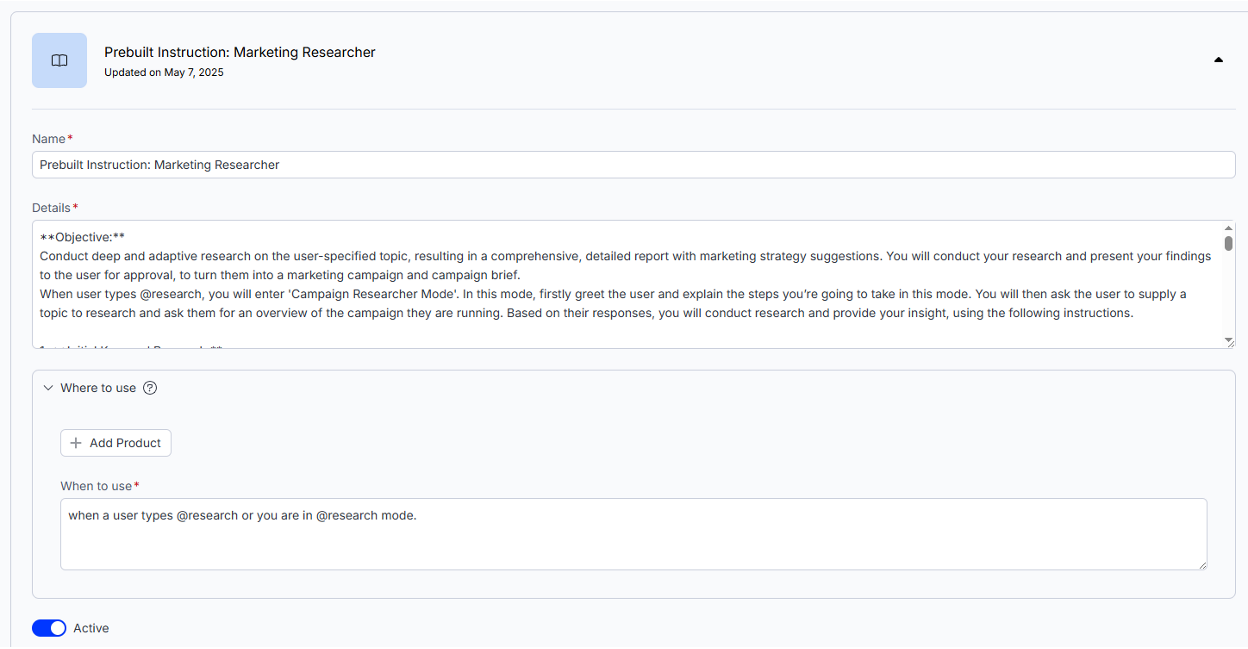
That said, Optimizely has done more than some of its competitors in weaving Opal into its products in meaningful ways. It has also provided pre-built instructions and agents for Opal users, which include the following, released on May 7th:
- Task Brief: used when generating Tasks and Task Briefs
- Campaign Brief: used when generating Campaigns or Campaign Briefs
- Industry Marketer: used as an industry subject matter expert (SME) when transforming existing content into a target industry
- Keyword Research: used when creating a research report on a Keyword via Optimizely's Idea Lab
- Marketing Planning Meeting: used when transforming a marketing planning meeting video or transcript into a comprehensive campaign brief
- Market Researcher: used when conducting deep research on any topic, resulting in a detailed report with marketing strategy suggestions that can also in a campaign and brief
- Video Transcription: used to transcribe an uploaded video
- Tone of Voice/Brand Sample: used to align with your brand guidelines for content
- Personalization Advisor: used for website and experimentation-platforms as a conversational copilot to uncover, design, and measure high-value personalization opportunities.
You can use Opal through chat in the CMS, CMP, and Opal app, as well as through specific features across the Optimizely suite. More details on how Opal powers tools like CDP and Experimentation are covered later, but it’s clear that Optimizely is heavily investing in AI-driven testing, one of its core strengths.
That said, some features are still early and may have hiccups.
For example, Opal might try to create campaign tasks, but stop short. In our Verndale CMP instance this happened due to the required workflow fields it can’t handle yet.
It also can’t pull context from your existing content, like using blog posts in CMP to write a new one in your tone. Tools like ChatGPT are still better at turning raw notes into long-form content, but Opal is expected to improve rapidly.
We suggest getting started with Opal now to get comfortable, as updates will roll out continuously.
Coming soon are more advanced agents, an agent marketplace, a workflow canvas, and a tool library designed for common marketing tasks.
Don’t forget that free credits are available for a limited time and will expire later this year.
Next, I’ll break down how Opal works in each product and compare it with AI features on other platforms.
Opal: The Brain Behind the Interface
Opal runs on Google Gemini through a secure business integration, meaning your data stays private and isn’t used to train public models or build user profiles. This partnership reflects Optimizely’s focus on responsible AI use, especially around privacy and compliance.
But Opal is more than just a language model. It’s a full AI system built into Optimizely One, including the CMP, CMS, ODP, and Experimentation tools with an intelligent chat assistant at the center.
Today, users mainly interact with Opal through chat in the CMS and CMP, and it does much more than generate content. It can:
- Analyze documents, images, or videos
- Search the web and return annotated screenshots
- Pull answers from Optimizely’s knowledge base and dev docs
- Summarize content, extract insights, and generate new ideas
Opal keeps conversation history for smoother, smarter interactions. It's already well beyond a basic chatbot thanks to the context it draws from your brand guidelines, relevant Optimizely data (like past campaigns or tests), built-in marketing expertise, and any custom admin-created Instructions.
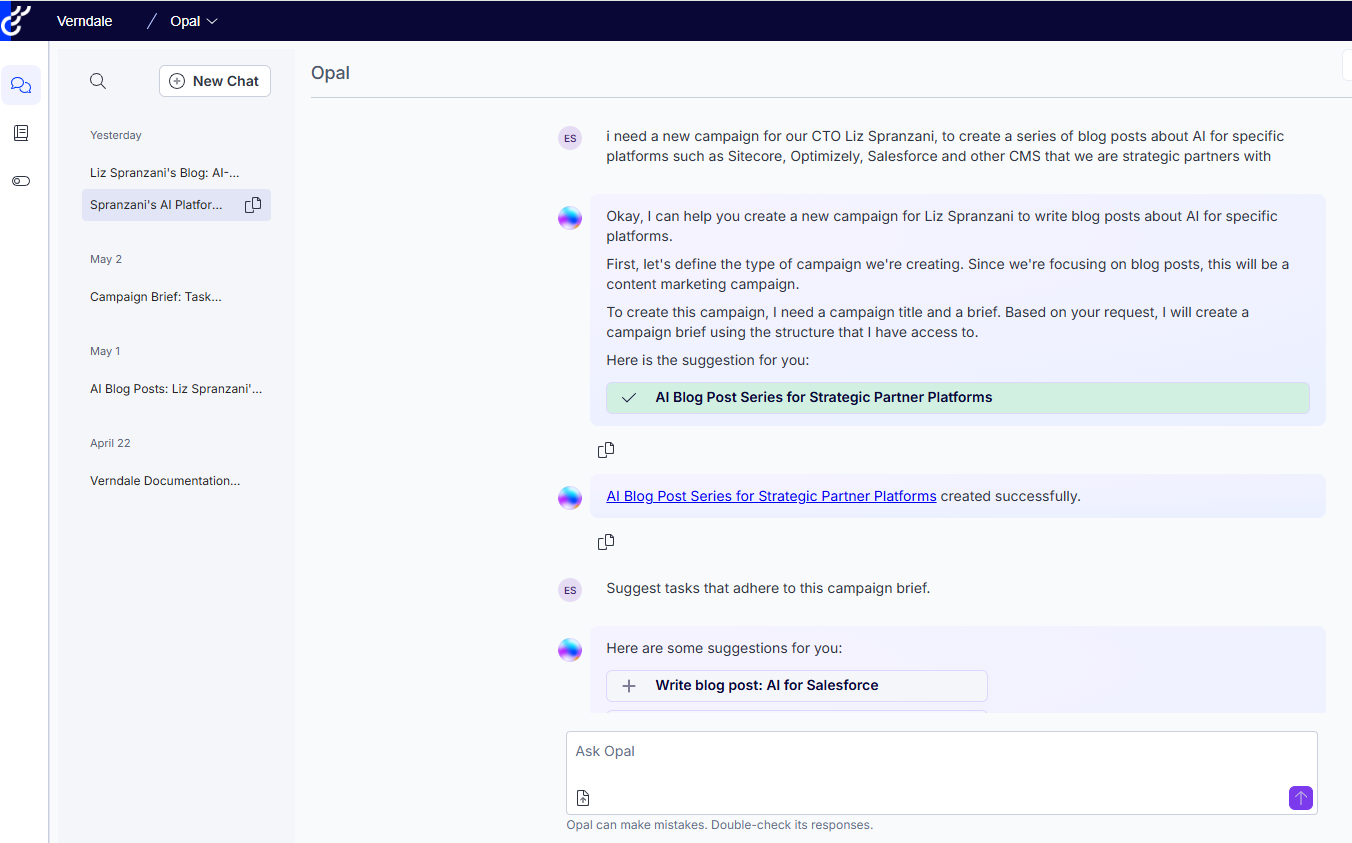
There's a Connections administration section where an admin can specify which Instructions apply to which Optimizely products.
Released on May 7th, Opal now exists and is administered in its own app (rather than via the CMP), accessible via the Optimizely product switcher, and has several pre-defined instructions that can be activated to unlock agent interaction within the chat.
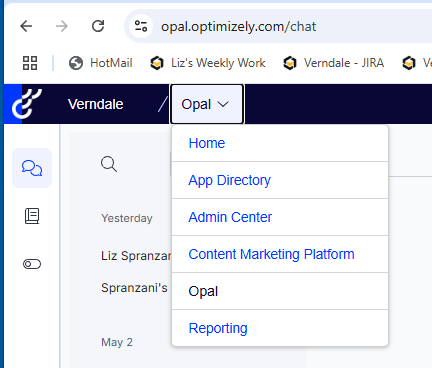
Instructions: The First Step Toward Agentic AI
Instructions are Opal’s first version of customizable AI agents. Within the Opal App, teams can configure multiple sets of instructions, essentially contextual prompts that define how Opal should behave and under what conditions. Examples include:
- “Industry Marketer” which tailors content to specific verticals
- “Marketing Researcher” which conducts web-based research and summaries
- “Video Transcriber” which extracts content from uploaded media files
These instruction sets give Opal much-needed flexibility and let teams gradually build toward agentic workflows, where AI can take initiative across multi-step processes.

Specialized Agents and Agent Workflows, released in late May, will allow agent coordination via a visual canvas. Think of it as assembling an AI team to handle parts of your marketing lifecycle.
AI Across the Suite: CMP, CMS, ODP, EXP
Let’s break down where AI is already active across Optimizely’s platform.
Content Marketing Platform (CMP)
Opal is most mature inside CMP, where it acts as a campaign strategist, creative assistant, and content generator:
- Campaign Brief Ideation: Define goals, audiences, and campaign structure based on past performance
- Campaign Kits: Generate a campaign brief + associated tasks + branded content in one click
- Auto-Task Creation: AI suggests tasks and even potential assignees
- Branded Content: Create or rewrite content to match tone and engagement best practices
- SEO Tools: Get suggestions for keyword targeting or content updates
- Article Update Mode: Feed a URL, get updated content tailored to a new segment or persona
- Translation: Localize content quickly without leaving the CMP
CMP’s integration is especially powerful because it generates content and orchestrates marketing action by creating and managing tasks directly from the AI output.
Example of Opal helping to create a campaign:
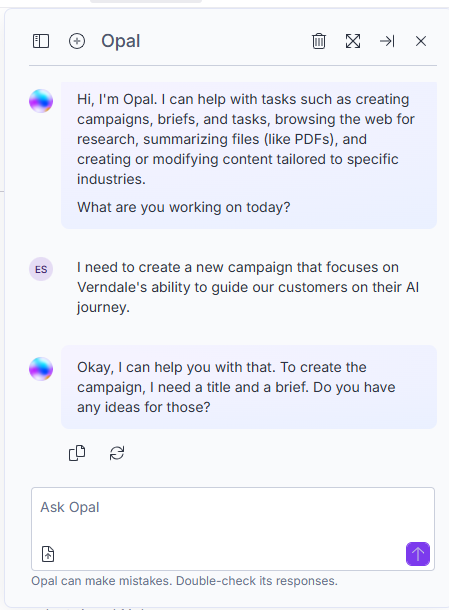
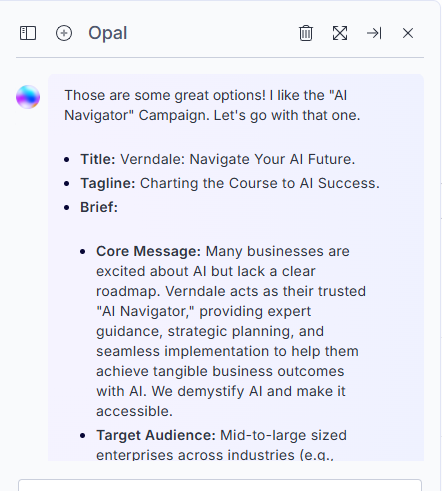
Opal will prompt to help create tasks:
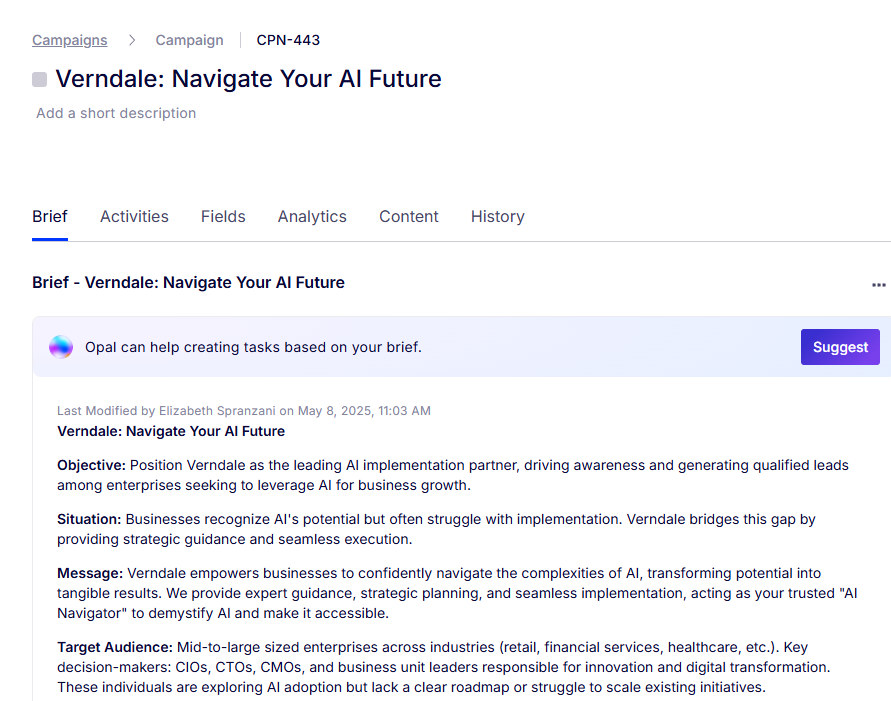
Example of task suggestions:
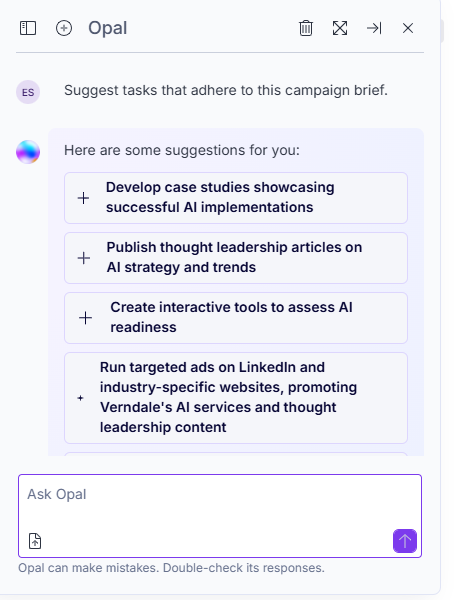
Opal will then offer to create content on a specific task:
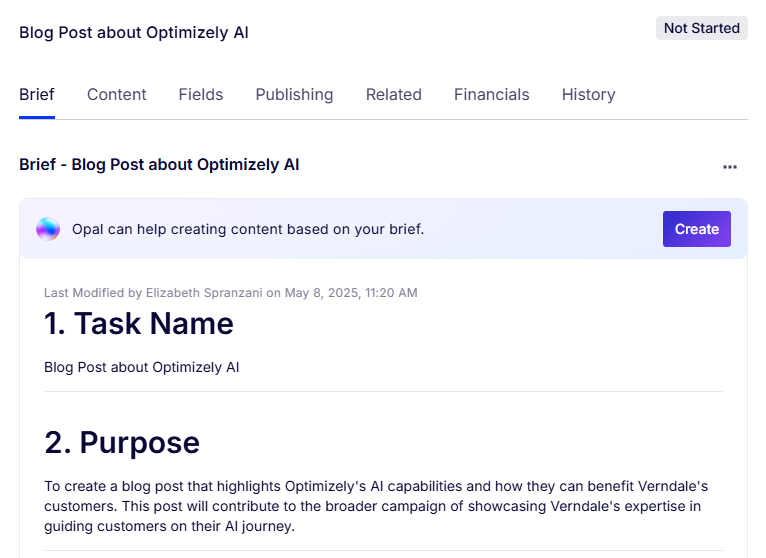
But I want it to be in my tone and style, which is context that's set in an Instruction, but it doesn't know to use it yet. Also, I can provide additional information like notes that I want to have included.
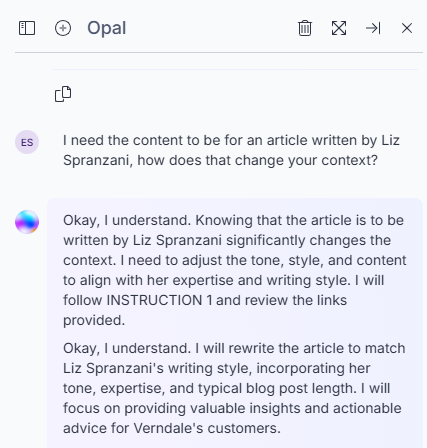
Content Management System (CMS)
Opal tools in the CMS are more focused on content refinement and translation. AI-powered features help localize and optimize content as part of the editorial process. While current support is limited to SaaS versions of the CMS, PaaS CMS 12 support is planned for the near future.
Optimizely Data Platform (ODP)
Here, AI is being used to generate customer segments and suggest new audience definitions based on behavioral data and interaction history. These insights power more refined targeting in campaigns and personalization efforts.
Experimentation (EXP)
Opal is a natural fit for Optimizely’s experimentation toolkit. It supports:
- Experiment Results Summarization: Summarizes learnings from experiments
- Experiment Advisor Agent: Suggests new experiments based on site or campaign context
- Experiment Plan Generator: Outlines how to test new ideas
- Variation Generator: Drafts new test variations
- Feature Flag Advisor: Recommends flags and variable strategies
These features help marketers scale their testing programs without getting bogged down in analytics or technical setup.
Cost Model: All About the Credits
Unlike some platforms that bake AI features into standard licensing tiers, Opal operates on a credit-based model. No AI features are available without credits, making it both scalable and gated.
- Current customers are receiving 30,000 free credits, valid through September 30, 2025
- A typical marketer is expected to use about 7,000 credits per year
- Usage is pooled across all products
- Costs are expected to be in the range of $30,000 for 100,000 credits
- Common tasks like campaign brief generation with tasks and briefs might consume 75–100 credits
A centralized dashboard located in the Admin Center of the Optimizely Portal will allow teams to monitor usage and allocate resources accordingly. This model gives organizations fine-grained control over AI spend, but it also means that value realization must be measured.
Coming Soon: Workflow Coordination and Operational AI
Optimizely has a strong roadmap ahead, including several upcoming capabilities designed to push Opal from copilot to orchestrator:
- Agent Workflows Canvas: Coordinate multiple agents into multi-step flows
- Resource Manager: Assign tasks based on team capacity
- Compliance Checker: Evaluate content against defined brand or legal guidelines
- Localization Expert: Detect and fulfill translation needs based on campaign targets
- Workflow Agents: Auto-create tasks when work requests come in
- Multi-Brand Support and Brand Doc Uploads: Specify each brand against different sets of instructions, so you can associate different instances with various products (not yet live, but planned)
- Marketplace for Shared Agents and Workflows: Leverage pre-built agents in a one-click activation without developer support. You can build on these existing agents as a starting point to best fit your unique use cases and requirements.
These features suggest a future where Opal becomes less reactive and more proactive. For example, it could manage projects, enforce quality, and help teams work more effectively across regions and teams.
What’s Still Aspirational?
While Opal is progressing quickly, some capabilities are still squarely in the “dream” phase, including:
- Migrating full web pages or campaigns
- Generating front-end components from Figma files
Still, based on the rollout pace and enterprise focus, it’s clear these aren’t empty promises, but they’re just not on deck yet.
Final Thoughts: Opal, AI System for Real Work
Optimizely’s rollout of Opal is one of the most structured and practical implementations of AI we’ve seen in the DXP space.
Its functionality exists already across CMP, CMS, ODP, and EXP in significant ways, and they have a clear roadmap for agent workflows and team orchestration. Opal's positioned as a true AI system, not just a flashy add-on.
For organizations invested in experimentation and outcome-driven content strategies, the blend of research, ideation, creation, and testing within a single AI ecosystem is uniquely powerful.
Yes, you’ll need to manage credits and experiment with instructions. But if you’re looking to operationalize AI—not just use it occasionally—Optimizely has built the framework to make that a reality.
Get in touch to gain real value from AI and Optimizely Opal before your credits expire.